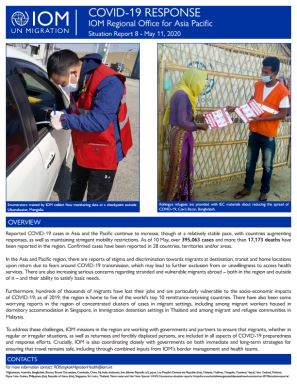-
Countries
-
Data and Analysis
-
Special Focus
-
Crisis Responses
IOM Asia Pacific Covid-19 Response - Situation Report 8 (11 May 2020)
Reported COVID-19 cases in Asia and the Pacific continue to increase, though at a relatively stable pace, with countries augmenting responses, as well as maintaining stringent mobility restrictions. As of 10 May, over 395,063 cases and more than 17,173 deaths have been reported in the region. Confirmed cases have been reported in 28 countries, territories and/or areas. In the Asia and Pacific region, there are reports of stigma and discrimination towards migrants at destination, transit and home locations upon return due to fears around COVID-19 transmission, which may lead to further exclusion from or unwillingness to access health services. There are also increasing serious concerns regarding stranded and vulnerable migrants abroad – both in the region and outside of it – and their ability to satisfy basic needs. Furthermore, hundreds of thousands of migrants have lost their jobs and are particularly vulnerable to the socio-economic impacts of COVID-19; as of 2019, the region is home to five of the world’s top 10 remittance-receiving countries. There have also been some worrying reports in the region of concentrated clusters of cases in migrant settings, including among migrant workers housed in dormitory accommodation in Singapore, in immigration detention settings in Thailand and among migrant and refugee communities in Malaysia. To address these challenges, IOM missions in the region are working with governments and partners to ensure that migrants, whether in regular or irregular situations, as well as returnees and forcibly displaced persons, are included in all aspects of COVID-19 preparedness and response efforts. Crucially, IOM is also coordinating closely with governments on both immediate and long-term strategies for ensuring that travel remains safe, including through combined inputs from IOM’s border management and health teams.

